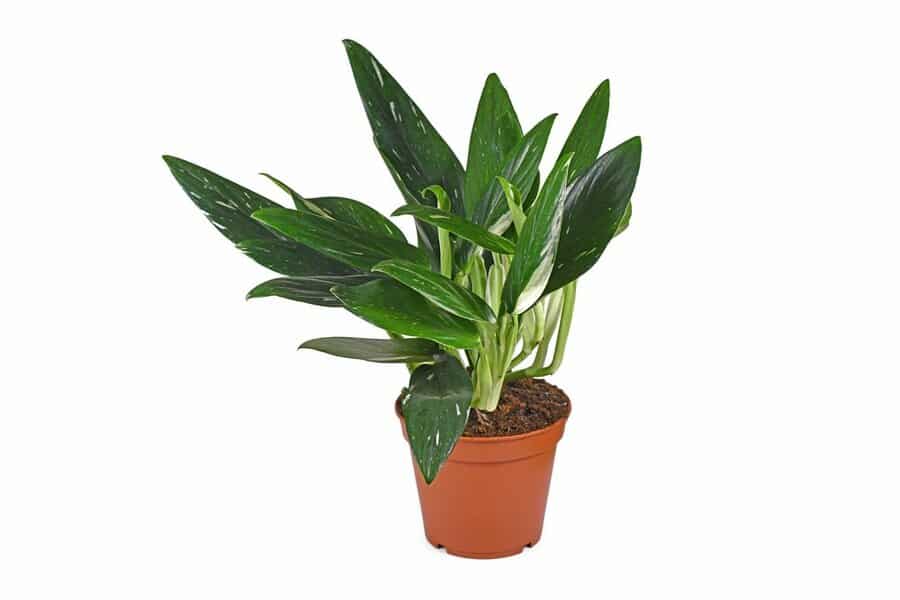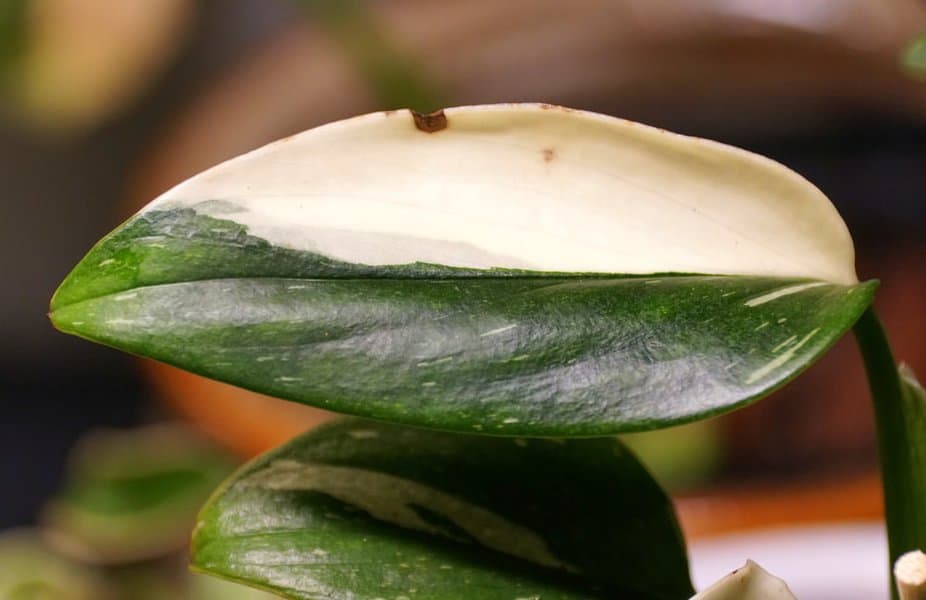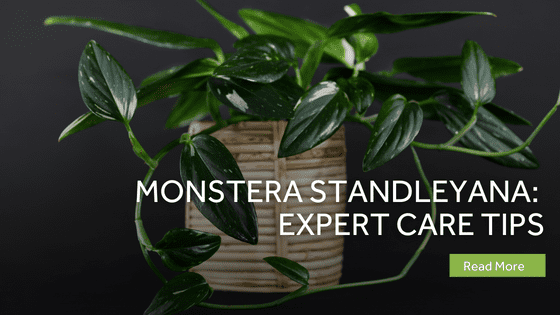If you’re looking for a rare plant in the Monstera genus, the Monstera standleyana is a beautiful option. It’s more difficult to find than other plants in its genus, but it’s easy to care for and is a beautiful addition to your indoor or outdoor garden.
Table of Contents
Monstera Standleyana Overview
The Monstera standleyana albo originates in South America, specifically Honduras, Panama, and Costa Rica. Most commonly, the standleyana climbs trees in the wild, but it can easily be grown indoors with proper care.
Commonly called the ‘five holes plant,’ the standleyana albo plant is from the Araceae family and the monstera genus. However, its nickname can be misleading since, unlike most other monstera plants, the Monstera standleyana variegata doesn’t get holes in the leaves.
Monstera, in Latin, means monstrous or sometimes abnormal, which is a good description of the Monstera plant as they often have holes or slits in the leaves, but again the standleyana plant doesn’t have the telltale holes.
Aside from the five holes plant, the Monstera albo standleyana has other names, including:
- Albo variegate
- Philodendron cobra
- Philodendron standleyana
Other varieties within the monstera genus include:
- Monstera lechleriana
- Monstera adansonii
- Monstera borsigiana
| Family | Araceae |
| Genus | Monstera |
| Origin | South America, Honduras, Panama, and Costa Rica |
| Sunlight | Indirect sunlight |
| Watering | Every couple of days in warmer months and once a week in cooler months |
| Soil | Well-draining and rich with organic material |
| Temperature | Warm temperatures of 70 to 85 degrees |
| Propagation | Root dividing or stem cutting |
| Re-Potting | Every 12 to 24 months |
| Pests and Diseases | Aphids, spider mites, scale bugs, and root rot |
| Toxicity | Very toxic to kids and pets |
Monstera Standleyana Features
The Monstera standleyana albo plant can grow as tall as 20 feet in the wild but remains a tame plant when indoors, growing to just five feet when in a pot. The spread on the plant is a maximum of three feet if you allow it to trail versus climb.
Mature leaves on the Monstera plant grow to 9 inches long and 4 inches wide. Its leaves also have impressive white ‘splashes’ that can take up more than half of the leaf. Despite being a climbing vine, the leaves on the plant also point straight up, which can be unusual.
The Monstera plant isn’t root-bound, so the roots need plenty of space to grow.
It’s important to note that the Monstera standleyana variegata is toxic and could be dangerous for kids and pets.

Monstera Standleyana Care Guide
Caring for the Monstera albo standleyana plant is easy, which makes it an excellent plant for beginners. It’s often recommended as a great first monstera plant because it is easy to take care of. Of course, it’s also a beautiful plant to add to your home.
Related Article: Variegated Monstera Adansonii: Instructional Care Guide
Ideal Growing Place
The albo standleyana is an outdoor plant because of its origins in tropical rainforests. However, this tropical plant does well both indoors and outdoors. Indoors, in a pot, it remains a tame climbing plant. Outdoors, it trails and vines, creating a beautiful ground cover.
Because the albo monstera standleyana is a tropical plant, it prefers warmer temperatures and cannot withstand cold temperatures or frost. Therefore, if you grow it outdoors, bring it indoors before temperatures drop below 55 degrees.
It’s also best to keep the plant away from drafts. Don’t keep it too close to a drafty window, door, furnace, or A/C. The draft can cause the leaves to wilt.
Water
It’s essential not to over-water the Monstera standleyana albo plant. Before watering it, check the soil with your finger. The top two inches should be dry before watering it. This plant doesn’t thrive in waterlogged soil. If the soil isn’t dry the day you check it, check again the following day.
In the summer months, the Monstera standleyana variegata may need watering as often as three times a week. However, in the cooler months, once a week is usually enough.
The Monstera plant needs adequate drainage holes. Letting the plant sit in water may result in root rot. However, insufficient water can cause your plant to stop growing and lose leaves.
The Monstera standleyana plant is great for telling you how you’re doing with the watering. Its leaves tell a story.
- Yellow, soft leaves – This signifies that you’re overwatering your plant. If the soil remains wet a few inches in a couple of days after watering, you’ve overwatered it. If you didn’t overwater, the plant might not be in a pot with good or enough drainage holes.
- Yellow, crispy leaves – This signifies that you’re not watering the plant enough. It could also mean the soil isn’t draining well enough. This happens when the soil on top is dry, but the roots are still soaked. Check the soil to ensure the water completely drains when watering your plant.
- Wilting leaves – If your plant’s leaves wilt, it’s another sign of underwatering your plant. Check your watering schedule and reassess the soil used to determine if it’s draining well enough.
- Dark brown spots – If your plant has dark brown spots and feels soft, it’s a sign of root rot or overwatering. Water less frequently to see if the spots clear up. If they don’t check the soil and the roots for root rot. If any roots are damaged, remove them and repot the plant.
Sunlight
The Monstera plant loves light; however, indirect sunlight is best. It does best in southern, western, or eastern facing windows.
If you have southern sun exposure, ensure the plant doesn’t get direct sunlight. Place it near a window with curtains that allow sunlight to gently hit the plant without damaging it.
If you only have a north-facing window available, it might work, but if you notice the leaves looking less ‘perky,’ you may need to add a plant light to ensure the plant gets adequate light all day.
Keeping out of direct sunlight is essential, as this can cause curling leaves on the albo monstera standleyana. Again, this is a sign of too much sunlight. Fortunately, moving it to a spot with filtered sunlight for a few days can bring the leaves back to life.
Temperature
Because the Monstera standleyana albo is a tropical plant, it likes warm temperatures, ideally between 70 and 85 degrees. It can tolerate cooler temperatures but nothing below 55 degrees.
Additionally, if there’s a threat of frost, it’s critical to bring the plant indoors until the weather warms again. While indoors, monitor the humidity levels to keep the plant healthy.
Soil
Soil is one of the most critical factors in a Monstera standleyana variegata plant’s health. It needs rich, organic soil that drains well. Avoid sandy soil and include as much organic orchid bark as possible to help the soil drain.
To create the perfect mixture, add two parts potting mix and equal parts bark and perlite. This allows the best drainage.
Humidity
Again, because the Monstera standleyana albo variegata is a tropical plant, it loves humidity. Ideally, your plant should have 55 to 80 percent humidity. However, because hot and humid is not likely how you live, there are other ways to give your albo monstera standleyana the moisture it needs.
Spritzing your leaves with a spray bottle daily and placing a pebble tray below the plant can help increase its humidity levels. If you have a humidifier at home, you can keep it in the room with your plant as well. Just make sure the humidifier isn’t on top of the plant. You can also place it in a steamy bathroom every day to give it the daily dose of humidity.
Fertilizer
Monstera plants only need fertilizer in the warmer months. So as soon as the weather cools, stop fertilizing it. Even in the warmer months, though, it doesn’t need a lot of fertilizer. So instead, fertilize the albo monstera standleyana once a month in the warmer months using an organic fertilizer.
Pinching/Pruning
You only need to prune the albo standleyana when the growth gets out of control. When you prune, trim the dead leaves only. This keeps the plant under control and stops it from getting unruly. Keeping the leaves maintained also keeps the plant healthier.
Potting and Re-potting
It’s important that the pot you place the Monstera albo variegata plant in has adequate drainage holes. It can usually stay in its original pot for 18 – 24 months. However, if you notice the roots growing out of the pot, repot the Albo monstera standleyana earlier.
When you repot the Monstera albo standleyana plant, take care of the roots. If you notice diseased or dead roots, trim them before repotting. This is also a great time to trim unruly roots to keep them from getting out of control.
When repotting, don’t go too big. Keep the pot within 2 – 4 inches of its original height.
Growth Zone
The Monstera standleyana grows best in USDA zones 9a to 11b.
Common Pests, Toxins, Diseases & Other Problems
Fortunately, the Standleyana plant isn’t affected by a lot of pests. The most common issue is spider mites. You can tell when your plant has spider mites because they create small spider webs throughout the plant. You may also notice the plant has brown spots circled on the leaves. It’s essential to cut out the affected areas and clean the leaves with insecticidal soap.
Sometimes Monstera standleyana variegated plants suffer from aphids too. If your albo monstera standleyana gets aphids, they could suck the nutrients from the plant. If you notice sap all over the plant, it’s a sign that aphids are sucking the sap from the plant. Make sure to clean the plant with insecticidal soap or neem oil to remove any residue.
Another common pest these plants suffer from is scale bugs. They look like brown bumps on the leaves. If left alone, they’ll suck out the plant’s nutrients and leave behind bacteria and fungus. You can remove them with your hand or a hose. Once removed, wash the leaves with insecticidal soap.
Propagation
You can propagate monstera standleyana albo but only in the spring. There are two ways to propagate monstera standleyana plants.
The first method is via root division. To do this, you must remove the Monstera standleyana from the pot. To divide the roots, you’ll need sterilized pruning sheers. You can sterilize them with alcohol. Once sterilized, you can cut the roots in half but leave more in the original plant than the propagated pieces.
You mustn’t plant the new plant in soil right away. Instead, leave it out for 24 hours to dry, plant it in soil, and water it.
You can also propagate using stem cuttings. To do this, cut a stem at least six inches long with two leaves. Make sure there is enough room over the leaf node for planting. If you want to speed things up, place the stem cuttings in water until the roots grow to about one inch. Next, plant the Albo monstera standleyana in the same type of soil used for the original plant.
Monstera Standleyana Mature Timeline
The Monstera standleyana is a fast-growing plant, so you should see new growth relatively quickly. However, you won’t have to wait long for its long beautiful leaves to grace your hanging plant or outdoor garden.

Monstera Standleyana FAQ
Is Monstera Standleyana a Fast Grower?
The standleyana albo plant is one of the fastest-growing plants around. Shortly after you pot it, you’ll notice it growing by leaps and bounds. Usually, plants have to be repotted within 12 to 24 months.
Where Can I Buy Variegated Monstera Standleyana?
You can buy the variegated Monstera standleyana plant on Etsy and many specialty plant nurseries. However, it is harder to find than other Monstera plants, so plan to look around a bit to find the perfect plant.
What Is the Difference Between Monstera Standleyana Albo and Monstera Standleyana Aurea?
The Monstera standleyana albo variegata is white variegated, and the Monstera standleyana albo variegata aurea is yellow variegated. The leaves on the albo plant grow to about six inches long and are thick with a heavy gloss. The aurea plant looks similar to the albo plant, but its leaves have a yellow tint versus white.
Are All Monstera Standleyana Variegated?
All Monstera standleyana plants are variegated plants. However, they may each look different, with speckles or splashes of white on the leaves. Remember, this Monster plant doesn’t get telltale holes in its leaves like most Monstera plants, even though it’s called the Five Holes plant.
What Does Monstera Standleyana Smell Like?
The Monstera albo standleyana plant doesn’t have much of a scent. However, if you notice a foul smell coming from the plant, it could be a sign of root rot or another issue causing disease leaves. If you notice a foul odor, you must take care of it immediately to avoid further damage to your variegated standleyana.
Why Doesn’t My Monstera Standleyana’s Leaves Have Holes?
Despite its nickname, the Five Holes plant, the Monstera standleyana leaves don’t have holes like most Monstera plants. So you don’t have to worry if your plant doesn’t have holes. However, if it does, it could signify something is wrong with your monstera standleyana albo plant.
When Will My Monstera Standleyana’s Leaves Get Holes?
The standleyana albo leaves don’t get holes. Instead, they have gorgeous variegated leaves with splashes of white throughout them for a beautiful look.
Why Is My Monstera Standleyana Leaves Curling?
When the leaves of a Monstera standleyana plant curl, it’s a sign of too much sunlight. As we mentioned earlier, these plants don’t like direct sunlight. Too much sunlight can scorch the leaves, causing them to curl. If you notice curling leaves, get the variegated standleyana out of the sunlight as soon as possible, and the leaves will begin to uncurl.
Where Can I Cut Monstera Standleyana?
You can cut the Monstera standleyana in two places when propagating it. First, you can cut it at the roots, dividing the plant in half. Your other option is to separate the stems, keeping a six-inch length with a few leaves for propagating your Monstera standleyana.
Can a Monstera Standleyana Live in Water?
The standleyana albo plant can live in water for a short time if you use stem cutting. This allows the plant to rest before repotting it for propagation. However, once in soil, ensure the plant doesn’t sit in water as this can cause waterlogged soil and root rot.
Is Monstera Standleyana a Succulent?
The Monstera standleyana is a climbing plant, not a succulent.
What Kind of Pot Is Suitable for a Monstera Standleyana?
Choose a pot that’s no more than a couple of inches bigger than the plant’s root ball. This ensures the roots will get enough water, but not too much. The pot should also have plenty of drainage holes to ensure the plant doesn’t get root rot.
Is Monstera Standleyana Variegata Rare?
The Monstera standleyana variegata is a rare monstera plant, but you can find it online and in specialty nurseries.
Is the Monstera Standleyana Toxic?
The Monstera standleyana is very toxic and should be kept out of reach of children and pets.
The Bottom Line
The Monstera standleyana is a beautiful plant to add to your collection. It also makes a perfect first plant because Monstera standleyana care is simple. The plant can be grown indoors or outdoors. It just depends on how much you want to let it grow and if you live in the right temperature for the plant to thrive outdoors.
Last Updated on September 7, 2022 by Gustaf Johansson




